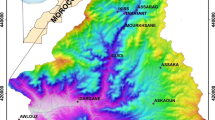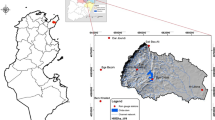Abstract
Soil erosion is a major global environmental problem. Therefore, a method of calculating potential soil erosion is necessary for soil and water resource management, as well as for assessing the risk of soil erosion. This study aimed to develop a simple method for calculating potential soil erosion change (PSEC) by combining the Universal Soil Loss Equation (USLE) and a Geographic Information System (GIS). The USLE model includes a rainfall erosivity factor (R), soil erodibility factor (K), cover management factor (C), slope gradient factor (S), length factor (L), and the supporting practice factor (P). Using a measured patch of soil and water conservation as the experimental unit, weather and soil data were combined to calculate R and K. Remote sensing images were used to extract vegetation cover (VC) and calculate C, while digital elevation models were used to extract and calculate S and L; land use maps were used to determine the P of each patch. The PSEC of each patch was then calculated according to the results of the above mentioned six factors. Finally, the PSEC of the entire study area was calculated on the basis of a patch area weighting method, which was validated in the Dacaozi Watershed in China, where a 1-year soil and water conservation project was implemented, beginning in November of 2013. In this study, the PSEC of the Dacaozi Watershed in May of 2017 was calculated, accounting for approximately 3 years of project implementation. The results showed that the average VC increased by 21.6% after 3 years of project implementation, whereas C decreased by 46.4%. The value of P did not change significantly from before to after project implementation. The average S decreased from 22.6 ± 12.1° to 21.3 ± 10.6°, and S decreased by 6.8%. In contrast, L increased by 33.3%. On the whole, the PSEC in the Dacaozi Watershed was 0.3925 and the potential soil erosion decreased by 60.75% after 3 years of conservation.





Similar content being viewed by others
References
Cai, C. F., Ding, S. W., Shi, Z. H., Huang, L., & Zhang, G. Y. (2000). Study of applying USLE and geographical information system IDRISI to predict soil erosion in small watershed. Journal of Soil and Water Conservation, 14(2), 19–24 (in Chinese with English abstract).
Foster, G. R., McCool, D. K., Renard, K. G., & Moldenhauer, W. C. (1981). Conversion of the Universal Soil Loss Equation to SI metric units. Journal of Soil and Water Conservation, 36(6), 355–359.
Honore, G. (1999). Our land, ourselves-guide to watershed management in India (pp. 238). New Delhi: Government of India New Delhi.
Khadse, G. K., Vijay, R., & Labhasetwar, P. K. (2015). Prioritization of catchments based on soil erosion using remote sensing and GIS. Environmental Monitoring and Assessment, 187(6), 333.
Khan, M. A. (1999). Water balance and hydrochemistry of precipitation components in forested ecosystems in the arid zone of Rajasthan, India. Hydrological Sciences Journal, 44(2), 149–161.
Le Bissonnais, Y., Montier, C., Jamagne, M., Daroussin, J., & King, D. (2002). Mapping erosion risk for cultivated soil in France. Catena, 46(2), 207–220.
Lee, S. (2004). Soil erosion assessment and its verification using the Universal Soil Loss Equation and Geographic Information System: a case study at Boun, Korea. Environmental Geology, 45(4), 457–465.
Li, J., Chen, X., Tian, L., Huang, J., & Feng, L. (2015). Improved capabilities of the Chinese high-resolution remote sensing satellite GF-1 for monitoring suspended particulate matter (SPM) in inland waters: radiometric and spatial considerations. ISPRS Journal of Photogrammetry and Remote Sensing, 106, 145–156.
Liu, Z. (2005). Retrospect and prospect on integrated management of soil conservation in small river basins. China Water Resources, 22, 17–18 (in Chinese with English abstract).
Liu, B. Y., Nearing, M. A., & Risse, L. M. (1994). Slope gradient effects on soil loss for steep slopes. Transactions of ASAE, 37(6), 1835–1840.
Mati, B. M., Morgan, R. P. C., Gichuki, F. N., Quinton, J. N., Brewer, T. R., & Liniger, H. P. (2000). Assessment of erosion hazard with the USLE and GIS: a case study of the Upper Ewaso Ng’iro North Basin of Kenya. International Journal of Applied Earth Observation and Geoinformation, 2(2), 78–86.
Millward, A. A., & Mersey, J. E. (1999). Adapting the RUSLE to model soil erosion potential in a mountainous tropical watershed. CATENA, 38(2), 109–129.
Moore, I. D., Gessler, P. E., Nielsen, G. A., & Peterson, G. A. (1993). Soil attribute prediction using terrain analysis. Soil Science Society of America Journal, 57, 443–452.
Pradhan, B., Chaudhari, A., Adinarayana, J., & Buchroithner, M. F. (2012). Soil erosion assessment and its correlation with landslide events using remote sensing data and GIS: a case study at Penang Island, Malaysia. Environmental Monitoring and Assessment, 184(2), 715–727.
Qin, W., Zhu, Q. K., & Zhang, Y. (2009). Soil erosion assessment of small watershed in Loess Plateau based on GIS and RUSLE. Transactions of the Chinese Society of Agricultural Engineering, 25(8), 157–163.
Renard, K. G., Foster, G. R., Weesies, G. A., McCool, D. K., & Yoder, D. C. (1997). Predicting soil erosion by water: a guide to conservation planning with the Revised Universal Soil Loss Equation (RUSLE). In K. G. Renard, G. R. Foster, G. A. Weesies, D. K. McCool, & D. C. Yoder (Eds.), Agriculture handbook (pp. 1–251) Washington.
Sharpley, A. N., & Williams, J. R. (1990). EPIC-Erosion/Productivity Impact Calculator: 1. Model documentation. Washington (DC): USDA Agricultural Reaserch Service.
Shi, Z. H., Cai, C. F., Ding, S. W., Li, C. X., & Li, T. W. (2002). Soil conservation planning at small watershed level using GIS-based Revised Universal Soil Loss Equation (RUSLE). Transactions of the Chinese Society of Agricultural Engineering, 18(4), 172–175 (in Chinese with English abstract).
Vittala, S. S., Govindaiah, S., & Gowda, H. H. (2008). Prioritization of sub-watersheds for sustainable development and management of natural resources: an integrated approach using remote sensing, GIS and socio-economic data. Current Science, 95(3), 345–354.
Wang, W. Z., & Jiao, J. Y. (1996). Qutantitative evaluation on factor influencing soil erosion in China. Bulletin of Soil and Water Conservation, 16(5), 1–20 (in Chinese with English abstract).
Wang, X. Q., Wang, M. M., Wang, S. Q., & Wu, Y. D. (2015). Extraction of vegetation information from visible unmanned aerial vehicle images. Transactions of the Chinese Society of Agricultural Engineering, 31(5), 152–159 (in Chinese with English abstract).
Wischmeier, W. H., & Smith, D. D. (1958). Rainfall energy and its relationship to soil loss. Eos, Transactions American Geophysical Union, 39(2), 285–291.
Wischmeier, W. H., & Smith, D. D. (1965). Predicting rainfall-erosion losses from cropland east of the Rocky Mountains. Washington DC: Soil Conservation Service, USDA.
Wischmeier, W. H., & Smith, D. D. (1978). Predicting rainfall erosion losses-a guide to conservation planning. Washington DC: US Government Printing Office.
Xu, Y. Q., & Shao, X. M. (2006). Estimation of soil erosion supported by GIS and RUSLE: a case study of Maotiaohe Watershed, Guizhou Province. Journal of Beijing Forest University, 28(4), 67–71 (in Chinese with English abstract).
Youssef, A. M., Pradhan, B., Gaber, A. F. D., & Buchroithner, M. F. (2009). Geomorphological hazard analysis along the Egyptian red sea coast between Safaga and Quseir. Natural Hazards and Earth System Sciences, 9(3), 751–766.
Zhang, Y. Q., Gong, H. L., Zhao, W. J., & Li, X. J. (2007). Quantitative evaluation and spatial analysis of soil erosion in Miyun County base on GIS and USLE. Research of Soil and Water Conservation, 14(3), 358–362,364 (in Chinese with English abstract).
Funding
This work was jointly supported by the Changjiang River Scientific Research Institute (CRSRI) Open Research Program [grant no. CKWV2016389/KY], the National Natural Science Foundation of China [grant no. 41501019], and the National Soil and Water Loss Monitor and Announcement [grant no. 1261520610101].
Author information
Authors and Affiliations
Corresponding author
Additional information
Publisher’s Note
Springer Nature remains neutral with regard to jurisdictional claims in published maps and institutional affiliations.
Rights and permissions
About this article
Cite this article
Huang, J. Assessment of potential changes in soil erosion using remote sensing and GIS: a case study of Dacaozi Watershed, China. Environ Monit Assess 190, 736 (2018). https://doi.org/10.1007/s10661-018-7120-6
Received:
Accepted:
Published:
DOI: https://doi.org/10.1007/s10661-018-7120-6




